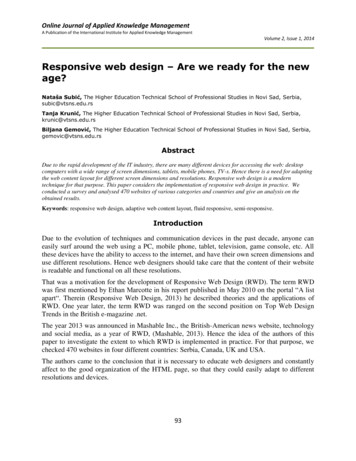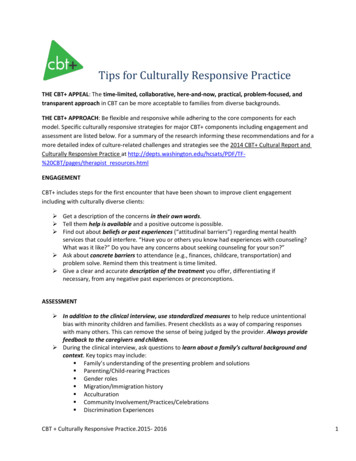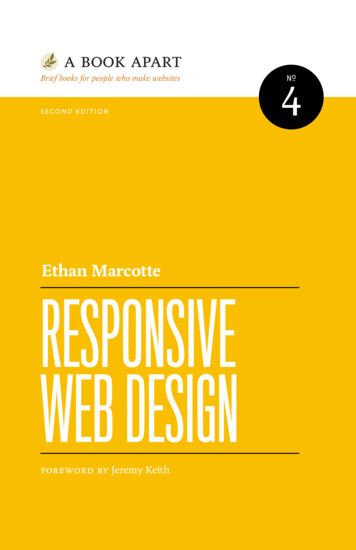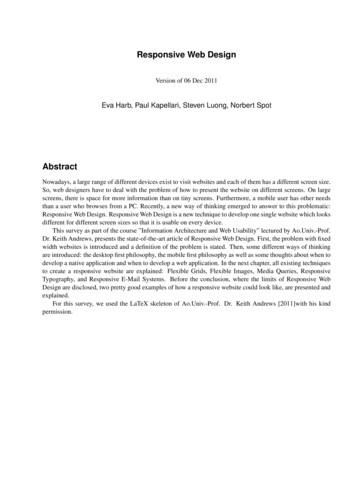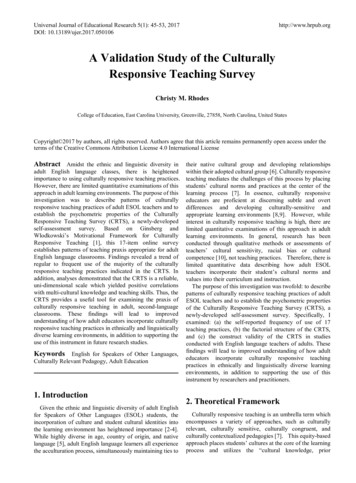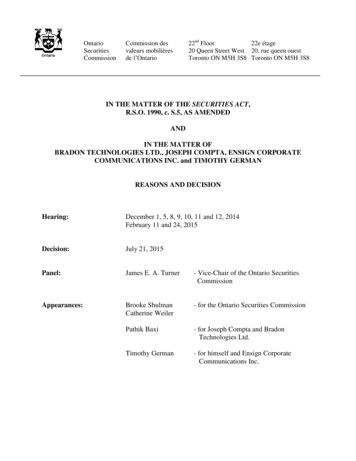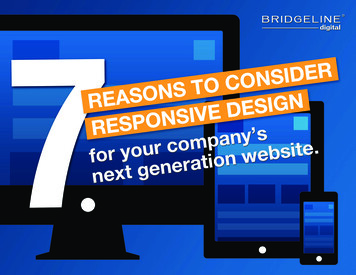
Transcription
7 REASONS TO CONSIDER RESPONSIVE DESIGN for your company’s next generation oitarenegtxen’synapfor your comAuthor: Eric BoyerEric Boyer has been passionately designing and building websites since 1999. He isthe Director of Interface Design at Bridgeline Digital where he has been recognized forhis work in responsive web design. He is currently working with clients such as PODS,Budget Car, and Children’s Hospital Colorado to increase the return on investment oftheir web properties and guide each into the responsive era.Co-Author: Ryan HadfieldRyan Hadfield has contributed to TIME, Boston.com (The Boston Globe) and has beenfeatured on MetaCritic for his work. He is the Deputy Editor of The Digital Engagementblog, where he writes daily about trends in the digital world for Bridgeline Digital. Hehas his Masters degree in Journalism from Northeastern University.2
7 REASONS TO CONSIDER RESPONSIVE DESIGN for your company’s next generation websiteOVERVIEW:‘Mobilegeddon’, Customer Expectations& Your Organization’s WebsiteSmart Device adoption is (still) experiencing a peerless boom. The staggering statisticssurrounding smartphone and tablet adoption as well as the devices’ use cases, whichwe’ll examine in this eBOok, has created a waterfall of sequences of events: Becausepeople, by and large, use smart phones, customer expectations shifted, especially inhow organizations adapt a web experience to their circumstances. Now, the idea ofmobile-friendly websites for businesses is no longer a thrill, it’s a requirement.You may read that last sentence as hyperbole, because, up to this point, whether or notyour organization adapted its web presence to meet the Mobile Revolution impacted yourbusiness, mostly, in intangible ways (branding, customer frustrations, and more). Makeno mistake about it, though: the deleterious effect was there. Smart digital marketingteams know this, but Google has since made it easier to convince organizations toadapt or die (at least in terms of visibility) to these consumer trends.Why? At its core, Google operates to serve its users. The legendary algorithm thatdetermines a querie’s search engine results page (SERP) has created an entire industryof professionals (SEO specialists, PPC agencies, etc.). And in late 2014, Googlebegan annotating whether or not sites were mobile-friendly in its search engine resultspage (SERP). This was the first step toward a new release in April of 2015, dubbed‘Mobilegeddon,’ which will start penalizing websites that aren’t optimized across alldevices. Google is serving its users, isn’t it time your organization does too?So, ask yourself: What are my options?3
7 REASONS TO CONSIDER RESPONSIVE DESIGN for your company’s next generation websiteDEFINING RESPONSIVE DESIGNWhen you first start off trying to solve a problem, the first solutions you come up with are verycomplex, and most people stop there. But if you keep going, and live with the problem and peel morelayers of the onion off, you can oftentimes arrive at some very elegant and simple solutions.Most people just don’t put in the time or energy to get there.- Steve Jobs, co-founder, chairman, and CEO of Apple Inc.Creating a web strategy to deal with the rise of mobile devices boils down to three primary options: Developing a Native App,designing a separate Mobile Site, or recalibrating your primary website with Responsive Design. There is no magic bullet; eachoption comes with advantages and disadvantages. Consolidating web properties to provide visitors a one-stop outlet thatalready exists only seems logical and prudent. Responsive Design fills that void.So, let’s define Responsive Design:Responsive Web design is the approach that suggests that design and development should respond tothe user’s behavior and environment based on screen size, platform and orientation. As the user switchesfrom their laptop to iPad, the website should automatically switch to accommodate for resolution, imagesize and scripting abilities. This would eliminate the need for a different design and development phasefor each new gadget on the market.- Kayla Knight, Smashing MagazineUsing in-depth research data and insights from leading industry experts, this eBook will explore 7 Reasons Why MarketersShould Consider Responsive Design for a Next Generation Website to bolster their digital marketing strategy.4
7 REASONS TO CONSIDER RESPONSIVE DESIGN for your company’s next generation websiteREASON #1:LOCAL SEARCH AND THE POWER OF ACCESSIBILITYFrom a business and engagement perspective, theperpetual adoption boom that smart devices haveWhat does this meanfor marketers?experienced over the last decade has created a wave oftrickle down consumers trends. In short, our behavior isThe short answer: Everything.now dictated by technology, and, how accessible we are to There is no such thing as awasted moment anymore.connecting with brands.Your website is a 24/7, 365This is perhaps best illustrated by a Morgan Stanley studyday promotional vehicle.which found that 91% of all smartphone users have theirphones within an arm’s reach 24 hours a day, 7 days aweek. Think about that. An arm’s reach!And, smart devices are constantly top of mind. KleinerPerkins Caufield and Byers found the average user checkstheir phone nearer to 150 times per day.REASON #1: CONTINUES.5
7 REASONS TO CONSIDER RESPONSIVE DESIGN for your company’s next generation websiteREASON #1: CONTINUEDThe accessibility of our devices enables us to use micro-moments in the day to get thingsdone, such as search, shop, communicate and keep entertained. We found that people oftenturn to nearby devices to complete spur-of-the-moment activity. In fact, 80% of the searches that happen on smartphones are spur-of-the-moment, and 44% of these spontaneoussearches are goal-oriented.- Dai Pham, Google MarketingWith Local Search, Users Don’t Have An APP-etiteHow do we, as marketers, capitalize on this unprecented, consistent connection to our cusotmers? Even if you’re the CMO ofa massive brand, relying on a native app to drive mobile success is risky, if not presumptuous. This requires a user to enter theirsmartphone’s marketplace, search for your organization, and download your app. This is hardly an act of spontaneity. It’s an incrediblyactive process; thus, with an app, your brand is counting on a consumer to be a brand advocate, rather than just a customer.Consequently, with an app, you’re diminishing the value proposition of compulsive, localsearch. And just how valuable is the trend of local search? A Google study, entitled “TheMobile Movement: Understanding Smartphone Users,” found 9 out of 10 smartphonesearches result in an action (purchasing, visiting a business, etc.). Moreover, Google laterreported that 50% of consumers who conduct a local search on their smartphone visit astore within a day, and 18% of those searches lead to a purchase within a day. Omni-channelmarketing demands an omni-channel web experience.6
7 REASONS TO CONSIDER RESPONSIVE DESIGN for your company’s next generation websiteREASON #2: BRANDINGRESPONSIVE DESIGN HELPS BUILD YOUR BRAND,NOT HURT ITHaving a great mobile site is no longer just about making a few more sales. It’s become a criticalcomponent of building strong brands, nurturing lasting customer relationships, and making mobilework for you.– Masha Fisch, Google Senior Product Marketing ManagerCMOs everywhere put tremendous onus on fostering a quality brand. Appearance and appeal can help a businessgrow. On the other end of the spectrum, negligence to proper branding can devastate a business.As recently as a few years ago, visitors may have given a business a pass if their website appeared fragmented on analternative platform to a PC. Contemporary websites, however, are held to a different standard. Visitors don’t care if awebsite looks great on a desktop, but appears disjointed on a smart device – they expect a company’s websiteto look good on any device. No matter what device a visitor is working off of, a bad website experience speaksvolumes about a company. And once damaged, a company’s image is difficult to repair.REASON #2: CONTINUES.7
7 REASONS TO CONSIDER RESPONSIVE DESIGN for your company’s next generation websiteREASON #2: CONTINUEDYour premium brand had better be delivering something special, or it’s not going to get thebusiness.- Warren Buffett, Investor and PhilanthropistIn the study entitled, “What Users Want Most From Mobile Sites Today,”Google found 72% of consumers expect brands to have a MobileFriendly website. In 2013, a company not equipped to match theirpersonal technology is, for lack of a better phrase, behind the times.A poor mobile experience leaves a negative mental footprint. Googlereported that 55% of respondents said a frustrating mobile experience72% of people expect mobile friendly websitehurts their opinion of a brand.You have to make sure that you offer all the functionality of your main site on your mobile site.As you add more features, that may become difficult to maintain. That’s where the beauty ofresponsive design comes in - you have one site but present it differently to different classes ofdevices.- Terence Eden, Mobile Industry Consultant8
7 REASONS TO CONSIDER RESPONSIVE DESIGN for your company’s next generation websiteREASON #3: COSTAVOID UNFORESEEABLE OVERHEAD COSTS& GAIN OPPORTUNITY COSTSFrom the point of view of the site owner, a site that uses responsive design only needs to bebuilt once - you don’t need to build a web version, a mobile version and a tablet versionseparately - so this usually saves time and money.- Maani Safa, Innovation Director SOMOThere is no way – absolutely none – to pigeonhole the cost of overhauling a website to take a Responsive Design approach. The truthis that Responsive Design is more expensive, but just how much more is not dependent on any specific driver. Like any web redesign,there are a multiple factors to consider.Breaking Down The AlternativesDesigning and building a separate Mobile Site is, in many ways, redundant; especially if a business can invest in creating a website thatfunctions across any platform. You’re team is stuck managing two websites. Furthermore, the mobile and parent sites compete withone another in terms of search, meaning you’re splitting SEO equity. Meanwhile, developing a Native App is not a one-shot proposition. Businesses need to develop separate apps for the iPhone, Android, Windows 8 phone, Kindle and other major mobile platforms.Naturally, this requires more capital.REASON #3: CONTINUES.9
7 REASONS TO CONSIDER RESPONSIVE DESIGN for your company’s next generation websiteREASON #3: CONTINUEDThe Cost of Losing Business Due to Poor Mobile Experience.A Google study found the following: 61% of respondents take their business elsewhere ifthey encounter a poor mobile experience. 67% of consumers said they’re more likely to make apurchase if a website is mobile-friendly.It doesn’t stop there. A robust mobile experience canlead to stronger conversion rates in the future. A study byForeSee Results, a leading customer experience researchagency, said 54% of respondents that are “highly satisfiedwith their mobile experience are more likely to consider thecompany next time they want to make a similar purchase, and twice as likely to buy from the retailer’s mobilechannel again.”10
7 REASONS TO CONSIDER RESPONSIVE DESIGN for your company’s next generation websiteREASON #4: FUTURE PROOF YOUR WEBSITEPROTECT YOUR WEB PROPERTIESIf the smart device ascent has taught us anything, it’s that versatility, more than anything else, is coveted by consumers. Theconvenience of accessing information, downloading the latestpop song, making reservations for dinner, or ordering a newpair of designer sunglasses, is now the standard the expectation. Your website needs to become your bestcustomer service representative, through an inherient ability toreact to the channel -- or device -- a visitor is using to engagewith your company.Too many sites do nothing, serving mobile visitors full-size web pages meant for desktopbrowsers. Treating mobile users as second-class web citizens is an insult, not to mentionshortsighted and foolish, considering the explosive growth in mobile browsing.- Michael Calore, Editor, Wired MagazineREASON #4: CONTINUES.11
7 REASONS TO CONSIDER RESPONSIVE DESIGN for your company’s next generation websiteREASON #4: CONTINUEDLooking Towards The Future.What’s scary is that somewhere – who knows, probably in a college dorm room or a cubicle in Silicon Valley – the nextgreat invention is being created. We don’t know about its aesthetics, its capabilities, its (gulp!) cost, but we do know it’scoming. And as smartphones have proven, its impact can be a Game-Changer. Not knowing what’s next is yet anotherreason why Responsive Design provides your company with the best solution to deal with the Mobile Revolution.The best way to predict the future is to invent it.- Alan Kay, Programming PioneerResponsive Design protects companies against the infiltration of new technology into the marketplace (to a degree,anyway). Think of all the sites that had to be redesigned when 800x600 desktop monitors became outdated; aresponsive website will be able to adapt to the iPad mini or a (fictional) supersized version.12
7 REASONS TO CONSIDER RESPONSIVE DESIGN for your company’s next generation websiteREASON #5: INCREASED VISIBILITYEMPOWER YOUR CONTENTLet’s go back to ‘Mobilegeddon.’ Getting the most out of web properties hinges on the ability to be found. We know that Google is the newbillboard. But what’s the new ‘word of mouth’? Content! And producing engaging web content can induce readers to share your websiteamongst friends and associates through social media and email, which, ultimately, puts eyeballs on your virtual home.In terms of mobile, one of the problems with Native Apps is that the content is not shareable. Web content on apps is exclusive to users whohave downloaded the app, precluding its virality. Meanwhile, mobile websites provide links that fail to translate to desktop users without appearing fragmented, hindering web content from being seamlessly shared and spread.Every time I click a link on Twitter to be taken to a mobile version of a website it’s incrediblyfrustrating. The page will either resize to fill my browser (but with none of the graphics or designof the live site) or remain fixed in a thin column. Neither of these experiences make me want toexplore the site, or to read more.- Mike Essex, eConsultancyResponsive Design uses one website and one URL shareable, in an optimal way, across all technologies, thus eliminating thiscross-technology, User Experience (UX) issues.REASON #5: CONTINUES.13
7 REASONS TO CONSIDER RESPONSIVE DESIGN for your company’s next generation websiteREASON #5: CONTINUEDAnother critical component in web visibility involves the use of cutting edge Search Engine Optimization (SEO) tactics.Google’s Mobilegeddon update is vital here, as Responsive Design not only remedies the ‘sharing’ issues created byapps and separate mobile sites by utilizing one URL which works across all platforms, but the approach also concurrently improves a website’s search rank.In fact, Google recommends websites leveraging Responsive Design. Below aretwo reasons explained from their recently released Developer’s Guide: Using a single URL for a piece of content makes it easier for your users to interact with, share, and link to yourcontent, and a single URL for the content helps Google’s algorithms assign the indexing properties for the content. No redirection is needed for users to get to the device-optimized view, which reduces loading time. Also, useragent-based redirection is error-prone and can degrade your site’s user experience.14
7 REASONS TO CONSIDER RESPONSIVE DESIGN for your company’s next generation websiteREASON #6: OPTIMIZE MOBILE MARKETINGRESPONSIVE WEBSITES AND EMAIL PLAY NICE TOGETHERWe’ve already gleaned enough figures to understandmCommerce’s current (and future) impact in the marketplace.According to Bank of America, retail revenue in European andU.S. markets from mCommerce reached nearly 26 billion in2012 and is projected to skyrocket to 67.1 billion in 2015.Consider this, according to research from Knotice, a digitalmarketing firm, 48% of all email opens in late 2013 wereopened from a mobile device.Research Courtesy of KnoticeREASON #6: CONTINUES.15
7 REASONS TO CONSIDER RESPONSIVE DESIGN for your company’s next generation websiteREASON #6: CONTINUEDThe trick is, how do we keep making those content-driven email relationships better and moreprofitable for all involved, marketers and customers alike?- Hunter Boyle on HubSpotWhat does this tell us?While it’s certainly not a novel tactic, email marketing is still very effective. A company should use HTML and marketingsolutions to produce mobile friendly (responsive) emails to support its mCommerce strategy, and to adequately takeadvantage of email marketing, it’s prudent to offer a common experience across both channels.In other words, customers who access your website through a well-designed mobile email could be turned off if theycome across a disappointing mobile website that lacks sufficient user-friendly functionality.16
7 REASONS TO CONSIDER RESPONSIVE DESIGN for your company’s next generation websiteREASON #7: MOBILE DEVICES, NOT PCs .ARE BECOMING THE PRIMARY SURFING TOOLThe benefits and safeguards that responsive design offers organizations during this digitaltransformation are clear: Your brand is enhanced, not undermined; search visibility protected,not hindered by the consequences of ‘Mobilegeddon.’But this reason isn’t about preservation; rather, the ways in which we think about mobile shouldspawn areas for opportunities. Believe that if you act now, you will grow now. As we’ll outlineon the next page, mobile use isn’t a trend, it’s just the way things are. Consumers are alwaysconnected; heck, per Internet Retailer, 75% of shoppers use their smartphone in-store, asthey’re accomplishing goals.It is time for small retailers to adjust their mindset when it comes to online shopping andembrace the opportunities. It shouldn’t matter through which channel people buy fromyou, only that they do.- Dan Cohen, The GuardianREASON #7: CONTINUES.17
7 REASONS TO CONSIDER RESPONSIVE DESIGN for your company’s next generation websiteREASON #7: CONTINUEDWill the world embrace smart devices tothe point that PCs become obsolete?It’s legitimate, then, to presume that the market for smartdevices is trending one way, while PCs is trending theWe’re not ready to make that leap of faith. On the contrary, opposite. Hitching your wagon to desktops COULD meanit is a fair question to ask; especially while coupling thesetying your virtual strategy to a device that doesn’t take fullstatistics with the fact that 2012 marked the first timeadvantage of your web properties.since 2001 that fewer PCswere sold than theprior year.18
7 REASONS TO CONSIDER RESPONSIVE DESIGN for your company’s next generation websiteIN CONCLUSIONRESOURCES & FINAL THOUGHTSResponsive Design does not heal a poor web strategy – it pushes a well-conceivedplan over the top.Plenty of well established businesses use Native Apps or Mobile Websites with success. But as we move toward a worldpredicated on convenience, a homogeneous web presence that doesn’t discriminate toward any specific platformscould be the difference between a good web experience strategy and a grossly successful web experience that createsdesired results and maximizes your Return On Digital Investment (RODI).You cannot predict the future. The only thing you can really do is show up for the present.Tablets are out there, smartphones are out there – we need to be present there. One of theways to really engage what’s going on now is to develop on the new platforms and push theenvelope.- Chris Marstall, Creative Technologist The Boston GlobeFor examples of a Responsive Design website produced by Bridgeline Digital, pleasevisit Wellbridge Website, The UPS Store and Triumph Motorcycle Merchandise Website. To take a look at otherResponsive Design web properties, please check out The Next Web Magazine’s slide show, entitled“29 New Inspiring Responsive Designs on the Web,”19
7 REASONS TO CONSIDER RESPONSIVE DESIGN for your company’s next generation websiteABOUT BRIDGELINE DIGITALTHE DIGITAL ENGAGEMENT COMPANYInterested in implementing Responsive Design?Bridgeline’s iAPPS platform deeply integrates Web Content Management, eCommerce, eMarketing, Social MediaManagement, and Web Analytics to help marketers deliver online experiences that attract, engage and convert their customersacross all digital channels. Bridgeline provides end-to-end Digital Engagement solutions and boasts an award-winning team of interactiveAward Winning iAPPS PlatformTo learn more about Bridgeline Digital’s integrated iAPPS Platform, please visit us at:BridgelineDigital.com 1-800-603-9936the digital engagement company
Responsive Web design is the approach that suggests that design and development should respond to the user’s behavior and environment based on screen size, platform and orientation. As the user switches from their laptop to iPad, the website should
